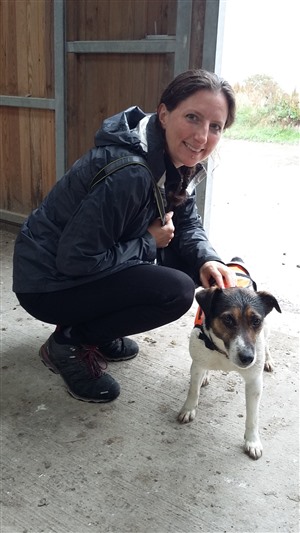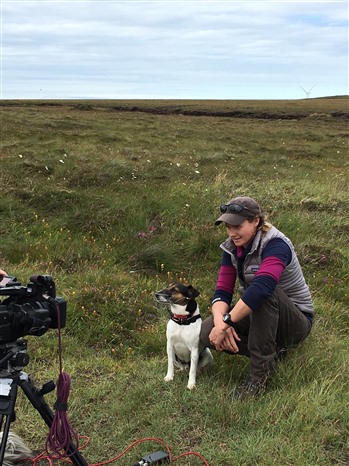Kirsty Nutt describes meeting the UK’s first stoat detection dog and the important role he and his handler Ange have in safeguarding Orkney’s native wildlife.
I have been part of the Orkney Native Wildlife Project team since 2016. For those of you that don't know, the Orkney Native Wildlife Project, which is a partnership between Scottish Natural Heritage (SNH), RSPB Scotland and Orkney Islands Council, aims to protect Orkney’s native wildlife by removing stoats, an invasive non-native predator that was first recorded in Orkney in 2010.
Stoats are native to the UK mainland, but not to Orkney, where they were first recorded in 2010 and where they pose a significant threat to Orkney's world-renowned and internationally important wildlife upon which Orkney’s thriving wildlife tourism industry relies.
I wasn’t sure what to expect when I first heard that the project would involve conservation detection dogs. I was intrigued because I hadn’t really heard of them before. I am obviously familiar with a range of working dogs and knew that drug and bomb detection dogs existed (probably from the TV) and even that dogs are used to search for illegally trafficked animal parts or survivors after earthquakes. But until a few weeks ago, I knew little about conservation detection dogs. I had no idea for example that the UK had newt detection dogs. I imagine few people do.
Last week, I met a conservation detection dog for the first time. His name is Macca and he is specially trained to detect signs of stoats. You may have seen him or read about him in the news.
Macca and his handler Ange (who is equally important but gets far less attention) have come over from New Zealand to fulfil a really important role in the preparations for removing stoats from Orkney. Their job, for the next three months, is to methodically search for signs of stoat presence on high-risk islands around Orkney Mainland.
High-risk islands are those within stoat swimming distance of islands where stoats are established – stoats are very competent swimmers and have been recorded swimming 3 km in open water.
Since 2010, when stoats were first reported, they have spread and established throughout Orkney Mainland and the connected islands. There have also been a handful of sightings reported on other non-linked islands including Hoy and, most recently, Shapinsay. Traps and motion-activated cameras have been used to try to determine whether stoats are present on these other islands following possible sightings, but so far have failed to provide confirmation.
We need to determine whether stoats are present on these other islands before the eradication gets underway. This is because we not only need to know whether we have stoats established on other islands and therefore a bigger challenge ahead, but also because the last thing anyone wants is to complete an eradication on the Mainland only to have stoats re-invade and be back to square one. This will be the largest stoat eradication ever attempted and it’s important that the investment of time, energy and money is effective but also that the whole project is as efficient as possible.
Stoats are notoriously difficult to detect particularly when they are at low densities. Therefore, the only way to be certain that stoats are not present is to use specially-trained conservation detection dogs, like Macca, to systematically search for signs and scent of stoats.
Over the last few days, I have been in awe of Macca’s exceptional patience and consummate professionalism especially while being followed around by microphones and cameras.
Along with media engagements, Ange and Macca spent last week acclimatising to being in Orkney and the new unfamiliar smells that Macca will encounter here such as Orkney voles. We also held two events, at the Orkney Auction Mart’s Glen Orkney Farm, last Friday to give folk a chance to meet them and see demonstrations of them in action. A big thanks to Stuart for patiently and generously hosting us. We will also be holding events on all the islands that they will be working on over the next three months starting with Shapinsay this Friday.
I really enjoyed being at the events on Friday. It was great to meet folk who want to protect Orkney’s native wildlife as much as we do, but also sad to hear from folk fearful about the lack of short-eared owls and hen harriers this year in places where they always saw them before. Although we can’t know if this is down to stoats, these are two species highlighted as being at risk by this SNH report.
What is certain though is that everyone who met Macca seemed to be as charmed by his placid, professional and unflappable character as I was and just as impressed at his ability to sniff out a stoat while seemingly ignoring everything else even rabbits bolting from right under his nose.
The demonstration part of the event is like a training game with a scent trail set out and a stoat scent hidden for him to find. It was great to watch him pick up the smell and become faster and more purposeful in his movements. In the first of Friday’s demos, the scent was put in the centre of a rough, grassy field – not very realistic stoat habitat, but much easier to watch – and he found it very quickly.
For the second demonstration, the canister containing stoat scent was hidden in a drystone wall. We watched, gripped, as he picked up the scent trail from distance, approached the wall and then moved in smaller and smaller circles to find the most intense concentration of scent. Once discovered he then indicated to Ange by wagging his tail, pawing at the wall and after a while barking to make sure we knew he had found his target. Once he knows Ange is aware of what he has found he relaxes a bit. Job done!
Between demos Mac had down time while we chatted, often sitting patiently, chasing a ball or finding someone to scratch his bottom at the sweet spot on his lower back just above his tail. It’s easy at times like that to forget that he is a serious working dog with an important job to do. When he is working he is quite a serious little chap, focussed intently on his task only pausing to check with Ange that he is going the right way. The relationship between the two of them seems very special and is integral to their successes. You can read about one of their New Zealand successes here but just two days before flying to the UK, Macca found a very active den of a stoat on a Kiwi creche island, an island where young Kiwi are put to grow and get big enough to fight off predators so they can make a home back on the mainland.
After a busy day, a nap in the office is needed
We are very fortunate to have both Macca and Ange in Orkney to share their vast skills, knowledge and expertise with us, but also because they are genuinely lovely, if only temporary, additions to our partnership team. They began work in earnest today on Shapinsay, where they will be for the next two weeks before moving on to Rousay, Hoy, and other islands. If you see them when they are out and about, feel free to say hello, but please do not disturb them from their important task.
Plans are in place to train six conservation detection dogs as part of the main Orkney Native Wildlife Project, to regularly check the high-risk islands, but also prevent stoats re-invading Orkney once the eradication is underway. So, Macca might be the first but won’t be the last stoat detection dog that is sent searching for the scent of stoats in Orkney.
Macca fact file:
- 4 years old
- Mum was a fine-boned fox terrier (perhaps with a little Jack Russell)
- Dad was a larger than average Fox terrier called ‘Scotty’
- Favourite toy is a big yellow fluffy duck that squeaks (slightly embarrassing for a serious working dog), but he also loves balls and sticks too, the bigger the better!
- Been working as a stoat detection dog since he was certified in 2015 when he was 15 months old.
Ange fact file:
- 38 years old
- Mum is an environmental planner
- Dad is a teacher (who’d rather be out sailing)
- Favourite food is wild venison back steak (rare)
- Started training conservation dogs in 2009. Currently has a rodent detection dog, Cody, as well as Macca.



